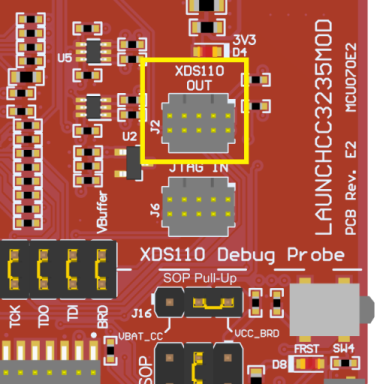SWRU548C February 2019 – September 2021 CC3235MODAS , CC3235MODASF , CC3235MODS , CC3235MODSF
- 1Introduction
-
2Hardware
- 2.1 Block Diagram
- 2.2
Hardware Features
- 2.2.1 Key Benefits
- 2.2.2 XDS110-Based Onboard Debug Probe
- 2.2.3 Debug Probe Connection: Isolation Jumper Block
- 2.2.4 Application (or "Backchannel") UART
- 2.2.5 JTAG Headers
- 2.2.6 Using the XDS110 Debug Probe with a Different Target
- 2.2.7 Power Connections
- 2.2.8 Reset Pullup Jumper
- 2.2.9 Clocking
- 2.2.10 I2C Connection
- 2.2.11 Sense on Power (SOP)
- 2.2.12 Push-Buttons and LED Indicators
- 2.3 Electrical Characteristics
- 2.4 Antenna Characteristics
- 2.5 BoosterPack Plug-in Module Pinout
- 3Layout Guidelines
- 4Operational Setup and Testing
- 5Development Environment Requirements
- 6Additional Resources
- 7Assembly Drawing and Schematics
2.2.6 Using the XDS110 Debug Probe with a Different Target
The XDS110 debug probe on the LaunchPad development kit can interface to most Arm® Cortex®-M devices, not just the onboard target CC3235MODSF device. This functionality is enabled by the J2 10-pin Cortex-M JTAG connector (see Figure 2-8) and a 10-pin cable, such as the FFSD-05-D-06.00-01-N (sold separately from the LaunchPad development kit).
 Figure 2-8 XDS110 OUT Connector (J2)
Figure 2-8 XDS110 OUT Connector (J2)Header J2 follows the Arm Cortex-M standard; however, pin 1 is not a voltage sense pin. The XDS110 outputs only 3.3-V JTAG signals. If another voltage level is needed, the user must provide level shifters to translate the JTAG signal voltages.
- Remove jumpers on the JTAG signals on the isolation block, including RST, TMS, TCK, TDO, and TDI.
- Plug the 10-pin cable into J2, and connect to an external target.
J2 follows the Arm Cortex Debug Connector standard outlined in Cortex-M Debug Connectors.
- Plug USB power into the LaunchPad development kit, or power it externally
JTAG levels are 3.3-V ONLY